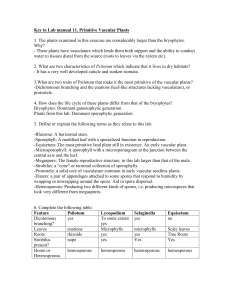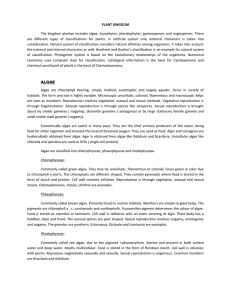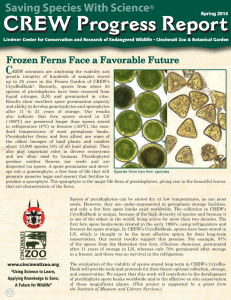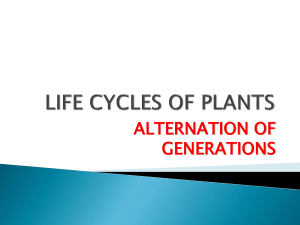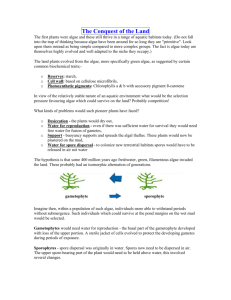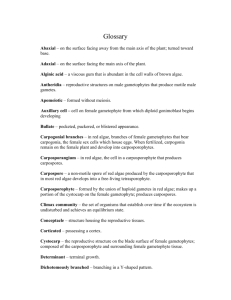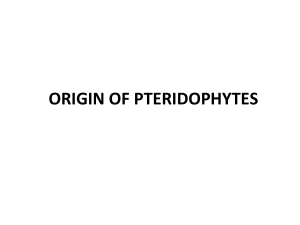AP Biology - PlantDiversity
advertisement
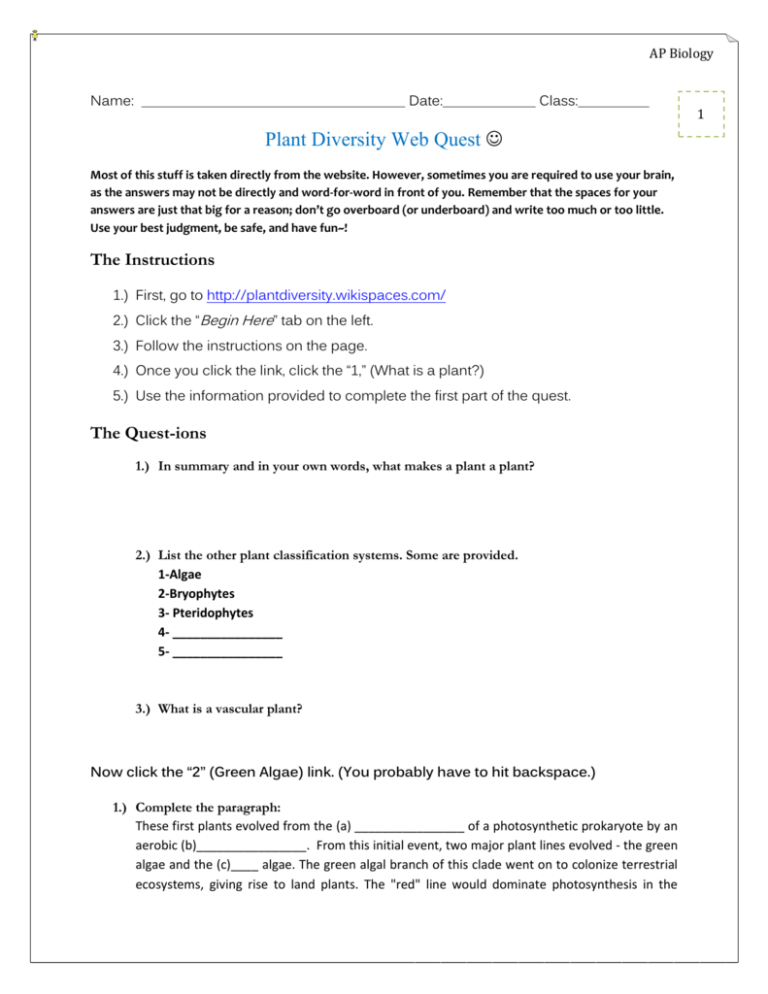
AP Biology Name: _____________________________________ Date:_____________ Class:__________ Plant Diversity Web Quest Most of this stuff is taken directly from the website. However, sometimes you are required to use your brain, as the answers may not be directly and word-for-word in front of you. Remember that the spaces for your answers are just that big for a reason; don’t go overboard (or underboard) and write too much or too little. Use your best judgment, be safe, and have fun~! The Instructions 1.) First, go to http://plantdiversity.wikispaces.com/ 2.) Click the “Begin Here” tab on the left. 3.) Follow the instructions on the page. 4.) Once you click the link, click the “1,” (What is a plant?) 5.) Use the information provided to complete the first part of the quest. The Quest-ions 1.) In summary and in your own words, what makes a plant a plant? 2.) List the other plant classification systems. Some are provided. 1-Algae 2-Bryophytes 3- Pteridophytes 4- ________________ 5- ________________ 3.) What is a vascular plant? Now click the “2” (Green Algae) link. (You probably have to hit backspace.) 1.) Complete the paragraph: These first plants evolved from the (a) ________________ of a photosynthetic prokaryote by an aerobic (b)________________. From this initial event, two major plant lines evolved - the green algae and the (c)____ algae. The green algal branch of this clade went on to colonize terrestrial ecosystems, giving rise to land plants. The "red" line would dominate photosynthesis in the 1 AP Biology oceans, both in terms of the red algae and the organisms which derived their (d) __________ from this "red" branch. The story of algal evolution is an intriguing one, with all other algal groups inheriting their(e) ___________________ ultimately from green or red algal ancestors. 2.) Fill-in-the-blank! The sporophyte phase of the life cycle produces spores by MEIOSIS. The gametophyte NEVER, phase EVER produces gametes FORGET (Yes, there are exceptions but this is a rule to remember.) 3.) Draw the life cycle of Derbesia and explain the steps in a few words: Click on # 3 , (Algal Evolution) 1.) by ___________. THIS! 2 AP Biology Fill in the blanks! A.)____________ B.)________________ C.)____________________ Everyone say thank you, Mr. Archibald! Diagram courtesy of John Archibald 2.) What happens in primary endsymbiosis? How about secondary? Click on #4, (The conquest of the land) 1.) Land plants evolved green algae, as suggested by certain common biochemical traits. Name those traits and explain 123- 2.)Fill in the blank! In view of the relatively stable nature of an aquatic environment what would be the selection pressure favouring algae which could survive on the land? Probably competition! What kinds of problems would such pioneer plants have faced? (a)____________ - the plants would dry out Water for reproduction - even if there was sufficient water for survival they would need free water for fusion of gametes Support - buoyancy supports and spreads the algal thallus. These plants would now be plastered on the mud Water for spore dispersal - to colonize new terrestrial habitats spores would have to be released in (b) ______ not (c)_______________ 3.) When did plants first move to the land? -Fossils of isolated land plant spores suggest land plants may have been around as long as (a)________million years ago -Fossils of land plant spores within plant fragments date back to 425 million years ago ( these were found in Oman and appear to be liverwort-like, although elaters are noticeably absent!) 3 AP Biology -Molecular clock (i.e.based on DNA sequence evolution) studies predict land plants appeared even earlier – (b)__________ million years ago Pretty neat, huh? Now click on the #5 , (The Bryophytes) 1.) Compare/ contrast bryophytes and other land plants. (Feel free to go out of the box if necessary.) Bryophytes Both Other Land Plants 2.) Name the (3) groups of bryophytes. Also, describe a little bit about each group. 3.) Vegetative reproduction Mosses and liverworts have two means of vegetative reproduction: (a) fragmentation - pieces of the gametophyte breaking off (the sole means of dispersal in the Arctic!) (b) gemmae - specialized propagules produced mitotically. They can also reproduce by….. ____________ _____________________________. 4 AP Biology 5 4.) What a great diagram! Fill in the blanks and make sure you understand it. Click on #6, (Bryophyte Spore Dispersal.) 1.) Label this diagram about moss capsule structure. 2.) How do the sections on the above diagram contribute to spore dispersal? AP Biology 6 Then click on the #7 (Introduction to the Pteridophytes) 1.) The above diagram is a life cycle of a typical fern. This diagram is applicable for all Pteridophytes! What is a pteridophyte? 2.) List the types of pteridophytes. 1234Click on #8, (Ferns) and read through the examples. You can use the examples on the AP test! There are some questions on the crossword about this, so be sure to go through it! Click on #9, (Fern Allies) and read through the examples. You can also use these for examples for the test. Same goes for this category; there are questions on the crossword. AP Biology 7 *BONUS* Yay! *sparkle sparkle* Find this image somewhere in the Web Quest! What is it? What are the things labeled A, B, and C? Crossword and the answers!!! ONLY USE TO CHECK YOUR ANSWERS! oocystis/an example of a colonial green alga isogamy/equal-sized motile gametes anisogamy/motile gametes almost equal-sized oogamy/small motile male gamete; large non-motile female gamete gametophytes/would need water for reproduction;A sterile jacket of cells evolved to protect the developing gametes during periods of exposure. sporophytes/spore dispersal was originally in water.Spores now need to be dispersed in air. cuticle/a new non-cellular, waxy, water-proof layer;evolved on the surface of the entire sporophyte.This minimised desiccation. basal portion/the lower portion of the sporophyte attained a role of anchorage. It became little more than a few thread-like rhizoids. transport system/with the increased bulk of the sporophyte, simple diffusion would no longer be adequate - evolution of the stele, i.e. xylem and phloem for transporting water, minerals and organic material. oil bodies/liverworts can also be distinguished from mosses by the possession of _________, unique organelles. circinate vernation/term used to describe the protective coiling of young fern leaves into a spiral like a shepherd's crook or bishop's crozier or a fiddle head. sori/fern spores are contained in sporangia which are borne on the leaf surface in clusters called ________. lepidodendron/was a giant tree-like club moss. It towered to 45 m in height and flourished in the swamp forests of the Carboniferous.(extinct) monilophytes/all ferns, whisk ferns, horsetails lycophytes/clubmosses, spikemosses, quillworts
